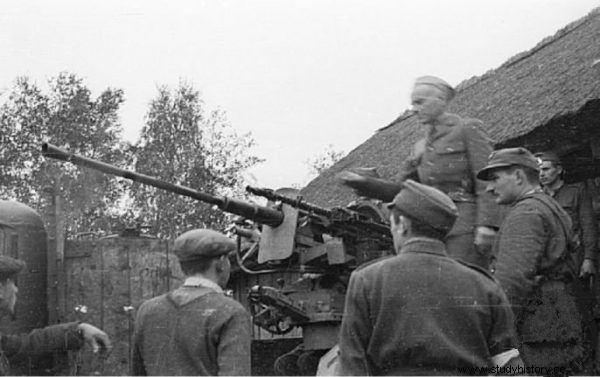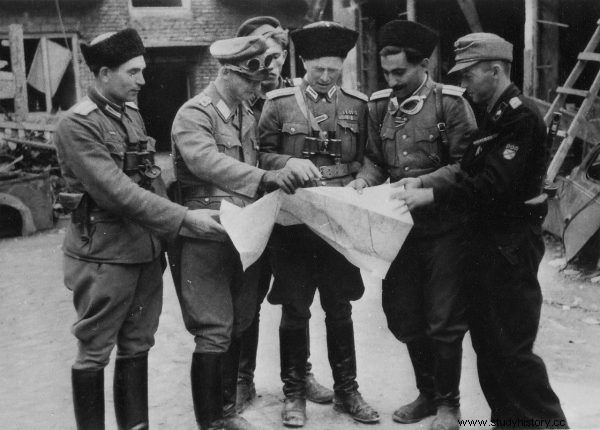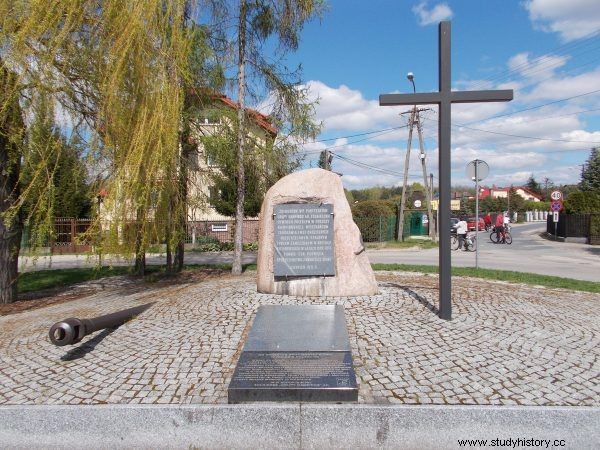One Pole for twelve SS men. And a great military success that is far too seldom talked about. "We beat them there, I think they took away about three hundred coffins. We took our revenge for Warsaw" - one of the participants of the battle recalled bluntly.
Partisan units repeatedly had to face the overwhelming enemy forces, emerging unscathed from numerous manhunts and ambushes. However, there were commanders who initiated the fight against a much larger enemy themselves, nevertheless achieving spectacular successes.
On the night of September 2-3, 1944, 80 soldiers from the Home Army Group "Kampinos" under the command of the Cichociemny Lieutenant Adolf Pilch "Dolina" broke up in Truskaw a group of SS men from the assault regiment of the SS RONA brigade (i.e. a collaborative unit of the Russian People's Liberation Army), counting about 1000 people.
At the end of August 1944, the German command, in order to cut off the Warsaw insurgents from outside help on the route leading from the Kampinos Forest to the city, deployed units of the SS RONA assault brigade regiment. Particularly troublesome for the partisans in Kampinos was artillery units located in Truskaw and Siaraków, which were firing at Home Army positions in nearby Pociesze.
In early September, "Dolina" introduced the group commander, Maj. Alfons Kotowski "Okoń" a bold plan to carry out an attack on enemy positions in both towns on the night of September 2 or 3. Initially, "Okoń" was against the idea, but Pilch's persistence won in the end. Cichociemny was to command the operation in Truskaw, and the group commander in Sieraków.

Major Alfons Kotowski "Okoń" speaks to the soldiers of the "Kampinos" Group. First from the right is Adolf Pilch "Dolina".
According to the intelligence carried out, the village was to contain about 500 roners and several cannons. It was quite a force. Nevertheless, out of the 600 soldiers who volunteered for the action, Pilch chose only 80 best armed partisans. The departure from the camp took place on September 2 at dusk. As the commander indicated:
We were given a lift to the leading outposts so that we could save as much energy as possible for the actual job. The journey along sandy forest paths took about two hours. The horses pulled the loaded carts with great effort. The fraternity sitting on the carts were dozing, wanting to rest a little longer before the busy night that was promising to be hot. I was on horseback with a few boys. The steady and monotonous movement was put to sleep. You had to exert all your willpower not to fall asleep, especially since I haven't recovered from dysentery yet
The submarines stopped in Zaborów Leśny, about 5 kilometers from Truskaw. Then the detachment went on foot. The soldiers walked around the town to make an attack from the side of Warsaw, from where, it was believed, the enemy would not expect a threat. Pilch divided the soldiers into three groups. The first, under the command of Cichociemny Lieutenant Tadeusz Gaworski "Lawa", walked along the right edge of the village, people of Lieutenant Aleksander Wolski "Jastrzeb" followed the middle, and to the left a group under the command of Cichociemny Lieutenant Lech Zabierek "Wulkan". "Dolina" with a few soldiers stuck to "Lawiaków".

You can read about other successes of the soldiers of the Polish underground in the book by Wojciech Königsberg entitled "AK 75. Daring actions of the Home Army" (Znak Horyzont 2017).
The partisans were moving in complete silence in order to get as close as possible to the SS quarters. On the way, individual houses were checked for residents who could give the location of the enemy's positions. Eventually, the aged old man was found. Except almost completely deaf. In order to make contact, he was brought to one of the cellars, where "Hawk" shouted questions in his ear to make him hear anything. However, the information that could be obtained was not optimistic. It turned out that on September 2, the second RONA unit arrived in Truskavets, increasing the number of soldiers to 1,000. However, "Dolina" did not intend to withdraw.
The troops moved on. Around 1.00 the first shots were fired, after which the assault began. Soldiers fired on houses and then threw grenades inside. Ronowcy were completely surprised by the attack from Warsaw. They tried to save by escaping, some wearing only panties. Władysław Maciejczak "Lwowski" recalled:
It was all drunk, darli (sorry to speak) murders, but they were drunk in drebiazgi (sic!). And since they got used to not to ask, but to shoot, our people already knew. That's why we used this method of theirs - don't ask, just bang. Ours shot like a sieve. Likewise, we beat them there, I think they took away around three hundred coffins. We took our revenge for Warsaw, because they were those withdrawn from Ochota and supposedly to rest and destroy the bandits in the Kampinos Forest .

During the Warsaw Uprising, the SS men from the RONA Division were so brutal that even the Germans were shocked. The photo shows (in the center) the commander of the Waffen-Sturmbannführer der SS assault regiment, Ivan Frolov.
Some SS men, however, tried to defend themselves. Grenade launchers and machine guns sounded, but quite quickly everything fell silent. After the last marauders had been dealt with, the partisans started to eliminate the cannons. Grenades were thrown through the barrels and bundles of straw with artillery shells were set on fire under them. One gun was taken with the squad. A machine gun, a dozen erkaems and peems, two mortars, ammunition and a number of other materials were also obtained. The village was on fire. Carts with ammunition, which had arrived the previous day, also took care of it. We could hear missiles exploding.
The next day, the inhabitants of the surrounding towns, who dared to come to Truskavets, saw a real battlefield:
The view was terrible. Everywhere along the length of the village lay the corpses of human and horse. They were visible on the road and among farm buildings, they were also located in the fields outside the village. Many houses turned into firewood. The torn-out doors and windows indicated that life and death fights were fought in the buildings that survived the fire.
The amount of the enemy's losses was not clearly defined. The discrepancy in Polish sources ranges from 91 to 250 dead. Also, the number of killed partisans has not been established. The literature on the subject mentions from 7 to 10 soldiers killed and several wounded.

Monument in Truskaw, commemorating, among others, the victorious foray of Lieutenant Pilch's unit. Photo from the book "AK 75. Daring actions of the Home Army".
The success achieved in Truskaw on September 8 was described in the insurgent issue of the "Information Bulletin". In the text Successful fights for the Kampinos Forest (sic!) We read:
At night on 3rd bm. branches of A.K. carried out their own foray on the enemy concentrated in Truskaw and Sieraków. A gun with ammunition and machine equipment were obtained. 91 German and Ukrainian corpses were counted on the battlefield. As a result of the fight, the enemy left Sieraków.
The aforementioned attack on Sieraków, commanded by "Okoń", did not take place. RONA branches left the town earlier.
***
You can read about other successes of the soldiers of the Polish underground in the book by Wojciech Königsberg entitled AK 75. Daring actions of the Home Army which will be available on October 25th.
